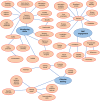Development of the face-to-face component and recruitment strategy of a primary care digital social intervention for patients with asthma: Qualitative focus groups and interviews with stakeholders
- PMID: 39329323
- PMCID: PMC11441056
- DOI: 10.1080/13814788.2024.2407594
Development of the face-to-face component and recruitment strategy of a primary care digital social intervention for patients with asthma: Qualitative focus groups and interviews with stakeholders
Abstract
Background: 5.4 million people in the UK have asthma, with one third experiencing suboptimal control, leading to co-morbidities and increased healthcare use. A quarter of people with long-term conditions informally access peer support through online health communities (OHCs). However, integrating online peer support into primary care services to facilitate self-management is a new concept.
Objectives: To develop together with stakeholders the content, delivery, and recruitment strategy of a digital social intervention to promote use of online peer support amongst asthma patients in primary care.
Methods: Data was collected by qualitative, audio-recorded, one-to-one interviews with clinicians, and focus groups with patients with asthma from East London general practices. The topic guide was informed by patient and public involvement work. Data collected was iterative (i.e. new ideas were added to subsequent interviews and focus groups). Verbatim transcripts were uploaded to NVivo12 and thematically analysed.
Results: Twenty patients from several ethnicities participated across five focus groups, and three general practitioners and three practice nurses were interviewed. The study's outputs included: the intervention's face-to-face content; content of clinician training; patient-facing leaflets/material; and a survey to recruit eligible patients. An intervention consisting of a structured consultation with a primary care clinician followed by OHC engagement, was developed based on three generated themes: 'introducing OHCs', describing how clinicians should introduce OHCs; 'OHC engagement', describing factors influencing OHC engagement; and 'clinician training'.
Conclusion: Findings will assist clinicians in consultations about supporting self-management of patients through OHCs. Future research should evaluate feasibility, effectiveness, and cost-effectiveness of such support.
Keywords: Primary health care; asthma; online health community; peer support; qualitative research.
Plain language summary
Promoting online peer support in primary care consultations is a novel concept.The study developed the content of a digital social intervention for patients with asthma.The findings of the current study will inform primary care clinicians’ consultations on digital social interventions and will be tested in a trial.
Conflict of interest statement
No potential conflict of interest was reported by the author(s).
Figures



References
-
- National Institute for Health and Care Excellence . What is the prevalence of asthma? 2023 [cited 2023 September 28]. Available from: https://cks.nice.org.uk/topics/asthma/background-information/prevalence/.
MeSH terms
LinkOut - more resources
Full Text Sources
Other Literature Sources
Medical
